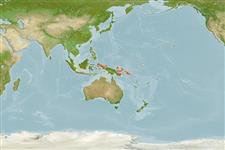>
Gobiiformes (Gobies) >
Trichonotidae (Sanddivers)
Etymology: Trichonotus: Greek, thrix = hair + Greek, noton = back (Ref. 45335).
Eponymy: Robert A ‘Bob’ Halstead (1944–2018) was an early innovator in the development of dive tourism, pioneer diving instructor and underwater photographer. [...] (Ref. 128868), visit book page.
Environment: milieu / Klimaatzone / Diepte / distribution range
Ecologie
marien demersaal; diepte 11 - 35 m (Ref. 90102). Tropical
Western Pacific: Papua New Guinea (Ref. 26146) and Indonesia (Ref. 28620).
Grootte / Gewicht / Leeftijd
Maturiteit: Lm ? range ? - ? cm
Max length : 15.0 cm TL mannelijk / geslacht onbekend; (Ref. 48636)
Dorsale zachte stralen (totaal) : 39 - 41. Trichonotus halstead is similar to T. setiger but has a beautifully colored dorsal fin (Ref. 48636). No free pterygiophores under dorsal fin (Ref 12934).
Body shape (shape guide): elongated.
Like other sand divers, it occurs on sand slopes with strong currents at times (Ref. 48636). Minimum depth reported from Ref. 26146.
Levenscyclus en paargedrag
Maturiteit | Voortplanting | Paaien | Eieren | Fecunditeit | Larven
Clark, E. and M. Pohle, 1996. Trichonotus halstead, a new sand-diving fish from Papua New Guinea. Environ. Biol. Fishes 45(1):1-11. (Ref. 26146)
Status op de Rode Lijst van het IUCN (Ref. 130435: Version 2025-1)
Gevaar voor de mens
Harmless
Gebruik door de mens
Tools
Speciale rapporten
Download XML
Internetbronnen
Estimates based on models
Preferred temperature (Ref.
123201): 27.5 - 29, mean 28.2 °C (based on 50 cells).
Fylogenetische diversiteitsindex (Ref.
82804): PD
50 = 0.5020 [Uniqueness, from 0.5 = low to 2.0 = high].
Bayesian length-weight: a=0.00389 (0.00180 - 0.00842), b=3.12 (2.94 - 3.30), in cm total length, based on all LWR estimates for this body shape (Ref.
93245).
Trofisch niveau (Ref.
69278): 3.5 ±0.48 se; based on food items.
Fishing Vulnerability (Ref.
59153): Low vulnerability (10 of 100).
🛈
